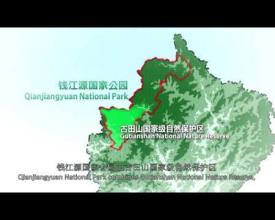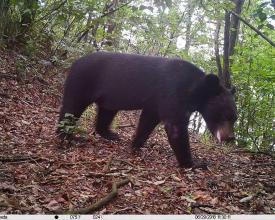
Guarding the window of the subtropical evergreen broad-leaved forest: the vivid practice of biodiversity conservation in Qianjiangyuan National Park, China

Qianjiangyuan National Park is situated in the Yangtze River Delta area with rich biodiversity. It is a rare area where the authenticity and integrity of the typical subtropical evergreen broad-leaved forest have been preserved despite long-term human activities. It is the distributional center of black muntjac and Elliot’s pheasant, Chinese endemic species. After becoming the first pilot program for China’s national park system, the Park adopts effective measures in good management, scientific research monitoring, protection and development and other aspects, such as implementation of easement reform for land management problems stressing on collectively owned forest, conducting biodiversity background investigation, and so on to build a model of national park construction in eastern China's developed regions. These effective measures have guarded the window of the subtropical evergreen broad-leaved forest and realized a vivid pattern of harmonious coexistence between man and nature.
Context
Challenges addressed
Qianjiangyuan National Park has a large area of primary forest, and also secondary forest, planted forest, economic forest land, agricultural land, and other ecosystems in different stages of succession formed by the different intensities of human disturbances.
The Park not only has abundant biodiversity resources and accumulates rich and effective management and protection experience but also faces the problems of bordering on three provinces, cross-regional coordination of nature reserve, easement reform, and the contradiction between biodiversity protection and social and economic development.
Although the long-term accumulation of scientific research can provide support for the management and conservation practice of the Park, there is still a gap between the understanding of the biodiversity information and its dynamic change law and the needs of the management, protection, and construction of the Park.
Location
Process
Summary of the process
The authenticity and integrity of the Park has been protected through innovative systems and mechanisms to achieve good management. For example, carrying out the reform of easement realizes the unified management of critical natural resources within the scope of the national park. The scientific and orderly promotion of scientific research monitoring has integrated the domestic and foreign scientific research institutes, colleges and universities, and supported and promoted the construction of the integrated "Space-Air-Ground" smart national park. The ecological corridors and the ecological restoration have solved the problems of fragmentation of animal and plant habitats, and strengthened the connectivity of essential habitats and expanded the area. Improving the coordinated development mechanism of communities and formulating various ecological compensation methods promote the coordination of the construction of surrounding communities and the overall protection objectives of the Park.
The above measures provide a replicable model for the development of national park construction in the Yangtze River Delta with a developed economy, dense population and the area with a high proportion of collective forest in the South China.
Building Blocks
Good management: innovation of system and mechanism for realizing authenticity and integrity protection
(1) Exploring the innovation system of easement reform and the diversified land management and utilization modes
According to the actual situation of different ownership of collective land, the Park studied and formulated different management methods of forest land, farmland, homestead, and water area in the Park and explored the land use modes of diversified land management in different functional areas.
(2) Realizing ecosystem integrity protection through cooperative protection
The criterion for regional cooperation protection is to protect the authenticity, representativeness, and integrity of the ecosystem and takes into account the area suitability and management feasibility.
(3) Optimizing functional zone division and implementing differentiated management
The current functional zone division is reasonable in the Park. On this basis, it can be further optimized and improved. For example, improvement of the proportion of core reserves and implementation of differentiated management.
(4) Formulating Regulations of Qianjiangyuan National Park
To regulate all activities and to protect the authenticity and integrity of the natural ecosystem, Regulations of Qianjiangyuan National Park has been preliminarily formulated according to China’s relevant laws and the Park’s actual situation.
Enabling factors
The basis for multi-level cooperation between governments at all levels in the past.
The Forestry Department of Zhejiang Province is the leading department of easement reform.
Qianjiangyuan National Park has carried out the work of confirming the right of natural resources assets, entrusted scientific research departments to conduct the research on the mode of easement system, formulated technical standards of easement system, and formed the implementation plan and management method of easement operation at the village level.
Lesson learned
Firstly, present confirmation of natural resource assets is mainly promoted at the national and provincial levels, and the Park is not an independent natural resource registration unit. The final results of the confirmation of natural resource assets have yet to be tested.
Secondly, there is a gap in the cognition of the national park in different regions, so differences in the demands of "rights, responsibilities and benefits" in cross-regional protection could lead to different intents of cross-provincial cooperation management.
Thirdly, there is a lack of successful experience for cross regional protection cooperation.
Scientific research monitoring: building biodiversity monitoring system to help scientific protection and effective management
(1) Integrated Space-Air-Ground biodiversity monitoring system
Space: used satellite remote sensing image to carry out multi-temporal image remote sensing monitoring in the Park, cross-provincial cooperation area and franchise area, and used ground and near-surface remote sensing data to interpret satellite remote sensing image.
Air: used aerial photography with Lidar, CCD high-resolution camera, and hyperspectral image to obtain the near ground remote sensing image of the whole Park.
Ground: established nearly 800 forest plots and set up 507 infrared cameras to carry out grid-level monitoring, covering the whole Park.
(2) Establishment of National Park Research Institute
To promote the construction in a scientific way, the Park will set up a National Park Research Institute, which will provide support for the scientific, accurate and intelligent construction and management of biodiversity protection in the Park.
(3) Building "Smart National Park"
By utilizing advanced technologies such as remote sensing, big data cloud computing and artificial intelligence, a big data cloud service platform for the Park has been formed. By combining mobile phone terminals with Internet technology, a comprehensive management and service platform for smart national park has been built.
Enabling factors
The Park worked together to conduct biodiversity research, public scientific education and practice with domestic and foreign scientific research institutions (Institute of Botany, the Chinese Academy of Sciences, Zhejiang University, Smithsonian Tropical Research Institute, Aarhus University, etc), and international environmental organizations (WWF, IUCN, etc).
Ministry of Science and Technology of China, National Natural Science Foundation of China, Zhejiang Province, and other government departments have provided rich financial support.
Lesson learned
At present, people's understanding of the long-term dynamic process of ecosystem is quite limited. The long-term monitoring and research on the typical ecosystems in the national park will deepen people's understanding of these ecosystems, optimize and update the objectives and strategies of national park protection.
Resources
Protection and development: dealing with conflicts between human and land correctly and laying the foundation of sustainable development
(1) Establishing ecological corridor to strengthen important habitats connectivity
The construction of ecological corridors strengthen the connectivity between different patches in the Park, and promote the diffusion of animals and gene exchange.
(2) Expanding effective habitat area by ecological restoration
The preparation of The Special Plan for Ecological Restoration has realized comprehensive evaluation of the vegetation status and identified the main areas that need ecological restoration in the Park.
(3) Reintroducing large carnivores for a complete food chain
In the future, reintroduction of large predators to reconstruct the integrity of the food chain will improve the ecosystem stability in the Park due to the increase or surplus of herbivores.
(4) Establishing compensation methods to promote ecological migration
The compensation policy for ecological migration actively encourages the residents living in scattered villages to move to towns or counties nearby and effectively enhances the effect of ecological protection.
(5) Conservation and community development coordination
The public participation mechanism has mobilized the enthusiasm of residents in the Park, and through information sharing, employment, etc, local residents' sense of belonging and honor has been cultivated.
Enabling factors
The culture of the natural environment is respected in the Park, such as "kill pigs and ban fishing," "kill pigs and seal mountains," "Gutian Seedling Protection Festival," and other simple environmental protection concepts and custom cultures such as Fengshui forest, famous ancient trees and other traditional forms of protection.
The construction of the national park provides favorable conditions for community residents to develop the private economy and obtain business income.
Lesson learned
At present, the education level of most community residents in the Park is not high, about 30% of them are in junior high school or below, so cultural education and employment management of residents need to be strengthened.
Impacts
Through unremitting efforts, Qianjiangyuan National Park has achieved remarkable achievement in the construction and management, and solved problems such as the fragmentation of animal and plant habitats, the weakening of ecological service function of secondary forest and plantation, and the contradiction between biodiversity protection and social and economic development, and basically achieved the primary goal of authenticity and integrity protection of the Park’s ecosystem. Currently, the Park has completed the reform of collective forest easement and 3,757 households involved have signed the collective forest easement contract, leading to realize the unified management of 80% of the collective forest land. In cross-regional cooperation, the Park has signed 12 cooperation and protection agreements with the governments at all levels of Jiangxi and Anhui province and realized the full coverage of the provincial cooperation and protection mode of adjacent towns and villages. The biodiversity monitoring in the Park has also achieved remarkable results. 293 papers have been published in the top international ecological journals, including 2 in Science and 221 in SCI journals. In addition, the Park has openly recruited 95 ecological patrolmen and provided 50 public welfare posts, which has promoted the participation of rural residents in collaborative community conservation.
Beneficiaries
Yangtze River Delta, China
Zhejiang Province and local governments at all levels
Qianjiangyuan National Park Administration
Local residents
Social public
Scientific research institution
Non-governmental organizations
Tour operators
Future generations
Sustainable Development Goals
Story

The evaluation of the management effectiveness of the protected area is an essential means to find out the management deficiencies, identify the management threats, and put forward suggestions to improve the accuracy and timeliness of the management of the protected area.
Based on the data collected by three long-term biodiversity monitoring platforms (forest dynamic plots monitoring platform, whole-park animal diversity monitoring platform and remote sensing monitoring platform) established in Qianjiangyuan National Park, the researchers comprehensively evaluated the protection and management effectiveness of the protected land from three aspects, including: the area and fragmentation degree of key protected ecosystem types in the protected area, the population change trend of the first-class protected animal and plant species, the ecosystem function of the protected area, in which the forest ecosystem takes the aboveground biomass and carbon storage as the main indicators). It is found that the main part of the key protected evergreen broad-leaved forest is located in the core protected area and the ecosystem conservation zone (89%), and the suitable habitat of the key protected animals Muntiacus crinifrons is 69.3% and 30.4% in the core protected area and the ecological conservation area, which shows that the functional zoning of the Park is reasonable. It is found that the population of Syrmaticus ellioti is increasing, while that of Muntiacus crinifrons is decreasing .The key ways to improve the protection effectiveness of the Park are to carry out cross regional cooperation to protect the evergreen broad-leaved forest and the habitat of endangered animals in the adjacent areas, and to carry out ecological restoration of the plantation in the area.











